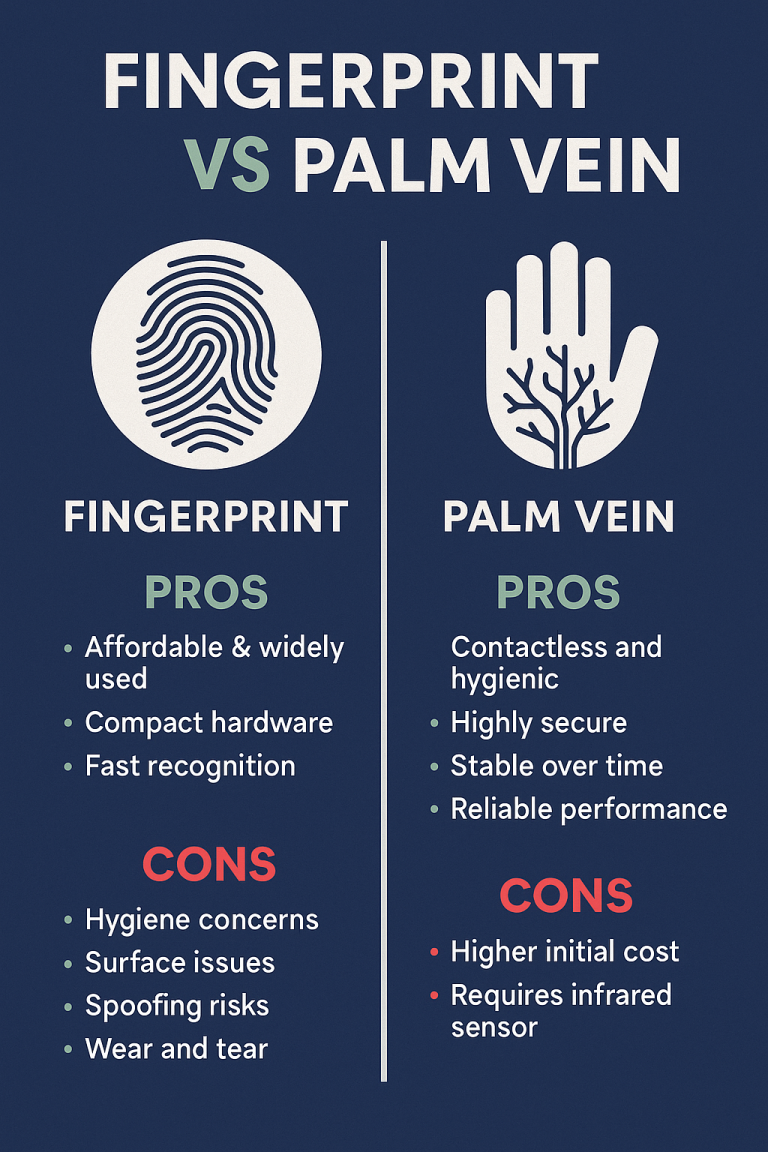In the world of biometric authentication, two technologies often lead the discussion: Fingerprint Recognition and Palm Vein Recognition. Both have revolutionised how organisations secure access, verify identity, and improve operational efficiency — but they are not created equal. Let’s explore their key differences, advantages, and limitations, and see why Palm Vein Technology is fast becoming the smarter, safer choice.
🔍 Understanding the Two Technologies
Fingerprint Recognition works by scanning the ridges and valleys on a person’s fingertip. These unique patterns are converted into digital templates used for authentication.
Palm Vein Recognition, on the other hand, goes beneath the skin. It uses near-infrared light to map the unique vein patterns inside the palm — an internal, invisible biometric that is virtually impossible to replicate.
✅ Fingerprint Technology — Pros and Cons
Pros:
Affordable & Widely Used: Fingerprint sensors are low-cost and integrated into many devices.
Compact Hardware: Small sensors make it easy to embed in phones, tablets, and POS terminals.
Fast Recognition: Fingerprint scans are typically quick, often within a second.
Cons:
Hygiene Concerns: Requires physical touch — not ideal in healthcare, food service, or public environments.
Surface Issues: Sweat, dust, or damaged skin can reduce accuracy.
Spoofing Risks: Fingerprint patterns can be lifted or copied from surfaces, creating security vulnerabilities.
Wear and Tear: Sensors degrade over time with heavy use, affecting reliability.
💡 Palm Vein Technology — Pros and Cons
Pros:
Contactless and Hygienic: Users simply hover their palm above the scanner — perfect for hospitals, offices, and payment terminals.
Highly Secure: Vein patterns are internal and can’t be forged or copied. Even identical twins have completely different vein structures.
Stable Over Time: Vein patterns remain unchanged throughout a person’s life.
Reliable Performance: Works regardless of surface conditions like dirt, moisture, or skin damage.
Inclusive: Works for people with worn fingerprints (e.g., elderly, construction workers, medical staff).
Cons:
Higher Initial Cost: Palm vein sensors are more sophisticated and slightly more expensive.
Requires Infrared Sensor: Needs a certified optical system, not a simple camera.
🚀 Why Palm Vein Leads the Future
In a world increasingly focused on data security, hygiene, and user experience, Palm Vein technology offers a future-proof solution. It’s not just a step ahead — it’s a leap forward.
That’s why forward-thinking organisations are adopting Palm Vein Scanners for applications in:
Healthcare — contactless staff and patient verification
Financial and Banking — secure and fraud-free authentication
Education and Access Control — hygienic attendance systems
Retail and Payments — fast, touch-free checkout experiences
🟣 The Verdict
While fingerprint technology has served well for years, Palm Vein Recognition is redefining what secure identity means.
It’s cleaner, smarter, and safer — designed for a world that values both security and trust.
As technology evolves, Palm Vein isn’t just the next generation of biometrics — it’s the benchmark for the future.

